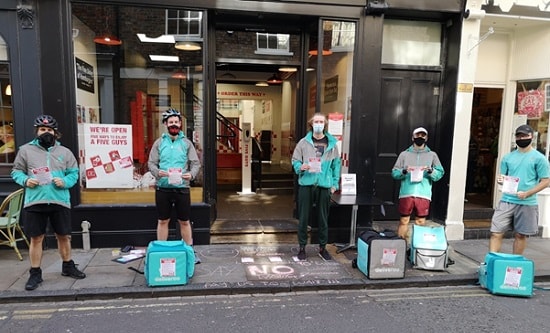
The latest employment statistics show the devastating impact of the coronavirus lockdown on precarious workers. Six months since restrictions ground work almost to a halt in sectors like hospitality, cleaning and childcare, economic shocks on the labour market continue to cause job losses and underemployment on a record scale. ADAM GREY reports.
In FRFI 277 we covered the steep rise in youth unemployment and the limited measures announced to stave off unrest. The effect on part-time workers, particularly women, and self-employed workers, has been just as severe.
Fighting for security
Although the employment rate has risen in recent years, much of this is insecure contract work for ‘platform’ companies like Uber and Deliveroo. From 2016 to 2019 the number of ‘gig economy’ workers doubled to 4.7m, almost 10% of the working population. These workers are tied to a particular employer but are denied the protections they would be allowed if they were recognised as workers, such as a minimum wage, holiday pay, and sick pay. Other precarious work such as agency employment, informal work and short-hours contracts is also on the rise. In June, 1.05 million people were on zero-hours contracts.
Such work has always been a part of capitalism, but its growth in Britain, alongside the erosion of legal protections for ‘permanent’ employees, is a symptom of the deepening crisis of capitalism, which increasingly limits the capacity of the British economy to pay off workers from the super-profits of imperialist plunder.
The capitalist accumulation process requires constant growth and leads to constant increase in the speed of production. In the retail and hospitality sector this has driven the move from independent shops, to nationwide chains, to the just-in-time delivery networks of ‘platform’ ecommerce. Ecommerce has risen from 6.7% of UK retail sales in 2010 to 19% in February this year, hitting a peak of 33% at the height of the lockdown in May. At that time, the number of food deliveries was up by 122% and retail deliveries by 62%.
The working conditions in the gig economy have met resistance from its growing workforce. There have been strikes, boycotts and walkouts. As a result of this political pressure, gig workers are slowly winning the legal rights of employees. This summer, rulings in favour of granting ride-share drivers employed status have passed in California and New York. A British Supreme Court case is set to make a binding judgement on Uber later this year. Canada’s courts have recently ruled that Uber drivers are entitled to sue for benefits. In Spain, legislation against bogus self-employment is currently being developed in association with rider unions.
Precarious unemployment
When capitalist crisis intensifies, precarious workers are the first to be forced out of employment. By June, the number of underemployed (those who work fewer hours than a standard full-time job, and want more) had increased sharply to 2.84m, its highest level in 5 years.
From March to August 695,000 employees dropped off of payrolls. In May to July alone there were 156,000 unplanned redundancies: the largest annual and quarterly increase in this figure since 2009.
Conditions are set to deteriorate further as state support for the labour market is withdrawn over the coming months. The Institute for Employment Studies estimated 445,000 dismissals would take place between July and September. More than half of these could be in the retail sector. The Bank of England projects a 7.5% unemployment rate by the year end.
Furlough failure
While the ‘furlough’ job retention scheme staved off mass unemployment, many furloughed precarious workers still experienced a loss in income due to losing out on tips and extra shifts. The scheme paid 9 million workers, with the arts and hospitality sectors seeing 60-80% of workers furloughed between April and July. A study published by the Resolution Foundation in May found that workers with insecure working patterns were most likely to be made redundant or furloughed, including 31% of employees working variable hours, and 28% of those on zero-hours contracts. 30% of the bottom fifth of earners had lost their job or been furloughed in the previous two months, compared to 10% of those in the top fifth.
A study from the University of Cambridge found that men were less likely to be furloughed than women, and of those who were furloughed, men were more likely to receive a discretionary wage top-up from their employer to make up the fifth not covered by the furlough payment. It also found that furloughed workers were under pressure to fraudulently continue working: 63% of employees admitted spending some time working for the employer who had furloughed them, of which some 20% were formally asked by their employer to do so. To employers, ‘free labour’ was easy to exploit when the threat of redundancy hung over their employees’ heads.
Self-employed gig workers are not eligible for furlough, despite private hire drivers in particular suffering a huge loss in custom while travel was restricted and there was nowhere open to go to. Following an outcry, a separate support scheme was announced belatedly in May to support lost earnings since lockdown began in March. Contrary to the regular furlough payments, this scheme paid a one-off lump sum covering 80% of three months of backdated average profits. This will have caused havoc for self-employed people unable to find work in the meantime, many of whom will have faced uncertainty and destitution until the grant came in. Yet the same scheme was refreshed in August, at a reduced 70% of average profits. But after that, self-employed workers, much like furloughed workers, will be left high and dry.




